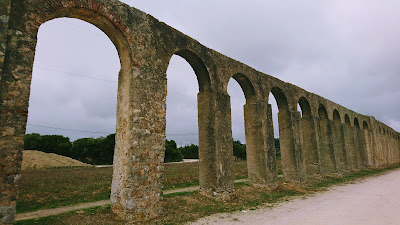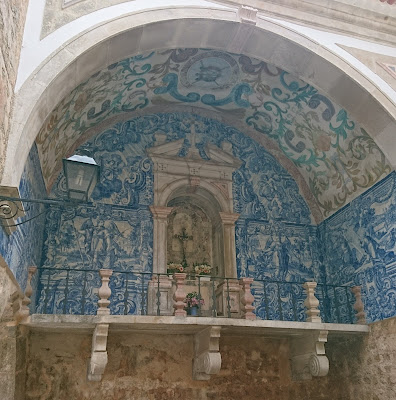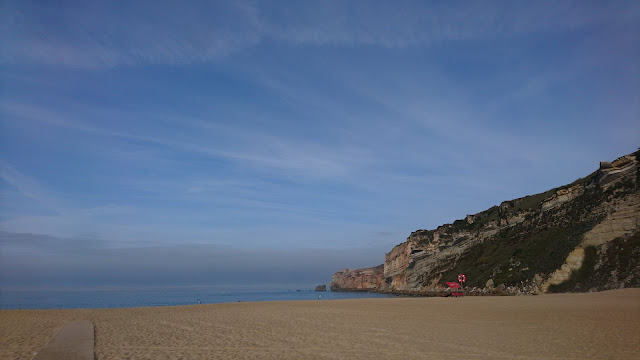Waiting for the waves
After my human got back from Berlenguas, we headed over to Òbidos, only 30km down the road. It is meant to be one of the prettiest towns in Portugal and of course, we had to see for ourselves.
And yes, as far as we can tell, obviously not having seen every town in the country, this definitely is a standout. It’s a tiny town, still surrounded by it’s town walls, dating back almost 1500 years. You can almost do a full circle on top of the walls, getting wonderful views of the settlement as well as the surroundings.
It being a Sunday, there were a lot of tourists around. There was also a literature festival going on at the time. Seems logical if you know, that Òbidos calls itself “City of literature” and was designated “Creative City” by UNESCO in 2015. After strolling through the narrow alleys and ducking into some of the many book shops, we left this very picturesque place to get to our final destination of the day, Nazarè.
Nazarè is known the world over for the biggest surf waves anywhere on the planet. Between November and February, the city, and especially the Praia do Norte beach, are overrun by surfers and visitors, all waiting for the big one.
Although it only happens three, four times every year, when it does, it must be amazing.
Unfortunately we are still a bit early and there wasn’t much happening yet.
 |
| This is where the magic happens. When it happens.... |
But we parked on a cliff above the beach to one side and the city to the other. Up here are a few shops and restaurants, some food trucks and a 12th Century chapel/fortress, sitting right on the tip. There is a 140 year old funicular connecting this original part of the city, Sitio, with the larger one below, Praia.
After walking to the castle and getting a good look at the beach, we settled in for a quiet evening with only the waves for background noise, once all the day visitors had left the car park.
 |
| The funicular is new, but the tracks are old |
In the morning Carmelo and my human walked down the hill to have a look around the city proper. Drying fish is a centuries old tradition here. So much so, that there is a museum dedicated to the art. Part of it is outdoors on the beach, where some ladies still dry the fish like their great-grandmothers did in the old days. You smell the place before you see it.
Other than that, there really isn’t all that much to see here. You can walk along the beach for a couple of kilometers to the harbor, stroll through the many narrow alleys and streets, and eat fish. But otherwise…
That’s why we left again around midday to head for Leiria. There has been a settlement around this area for ages, but the beginnings are obscure.
What is know, though, is that the town you can see today was built in the Middle Ages with what was left of a Roman settlement.
We parked on a gigantic lot next to the large stadium with a nice view of the castle perched on top of a small hill.
Which was the first port of call, naturally. For the extraordinary sum of 2,10 Euro, you can visit this impressive structure. It’s been rebuilt and remodeled so many times, it’s not exactly known, when the first structure was built here. But it’s been there for a long time!
Walking around the town itself was interrupted first by a bakery, then by a small café offering Franziskaner Weißbier. Who can say no to that? Of course we always try the local beer, but to be quite honest, Portugal still has a way to go until they brew good beer, it seems.
The car park runs alongside a small river, and after a quiet night, my human went for an early run. Her plan was to be back while it was still darkish, so as to have a quick outside shower. Well, she did have that quick shower. Darkish is relative, right?
One half of the parking seems to convert into a market every Tuesday. Besides clothes, household utensils and plastic flowers, you can also by live poultry and singing birds. But since we don’t need a pet, we left the market and Leiria behind, in favor for Tomar.
On the way there we stopped briefly in Fàtima. According to the church, three shepherd children had an apparition here in 1917. They saw a "lady more brilliant than the sun", who was holding a rosary in her hands. The lady appeared before them a few more times at specified dates and the last time she was seen, 70.000 people were present.
Or so they say.
After that, they built a chapel dedicated to "The lady of the Rosary", where the last apparation had taken place. The chapel nowadays is a large, sparsely decorated church, which holds the tombs of the three children.
Once you step out of the church, you face a very huge, very empty square. Empty that day, but on Easter, Christmas and the like it's filled with thousands and thousands of people.
Some of the people that were there that day, though, crawled towards the church on their hands and knees, some only on their knees. Not sure if there is a special word for robbing forwards on your knees only.
Across this square is another church, kind of buried into the ground. The Basilica of the Holy Trinity offers seats to almost 9.000 people. Besides a huge cross and mural behind the altar, the church could also be a convention center. Which is kind of refreshing, after all those over-the-top-full-of-gold-and-wealth churches we've seen lately.
 |
| Trying to be polite, she didn't take a close up, but you can see a couple of people on their knees |
The town of Tomar was born inside the walls of the Convento de Cristo, constructed under the orders of Gualdim de Pais, the fourth grand master of the Knights Templar in the late 12th century.
Although it’s situated inland, more than 50km away from the coast, it was especially important in the 15th century when it was a center of Portuguese overseas expansion under Henry the Navigator, the Grand Master of the Order of Christ, successor organization to the Templars in Portugal.
Here we found a great spot for the night on an old camp ground. All installations are still there, but now it’s for free, because it’s not really looked after. In a few years it might be a bit shabby, but for now it’s still great. There are outdoor showers, fresh water, waste disposal, all stet between large trees on grassy islands. And all that 5 minutes from the center. Thanks, Tomar.
After enjoying the place for a couple of hours, reading in the sun, they checked out the castle and walked through the small town. There is a nice large park with a few different walking routes. More of a forest, really than a park. No noise but the birds and your feet on the gravel - marvelous!
After a less than satisfying dinner experience in one of the restaurants in town, she hoped for a nice crowd to watch the Champions League match with in a nearby bar. Porto was playing, so she figured there would be people out watching the match. But Tomar doesn’t seem to be interested in soccer. In fact, besides the barman, she was the only one actually watching the match.
After some morning Yoga and the usual household activities, we were off again, headed further inland and up to Seia. Located on the edge of the Serra de Estrela National Park, this town is one of the gateways to the highest mountain in Portugal, on the mainland, at least, Torre. It stands at 1993 meters, pretty much in the middle of the country.
The town itself is pretty unremarkable, but the lady at the tourist information was very friendly and helpful. So was the guy at the Serra de Estrela Interpretation Center. But that’s really all there is to say about this place.
Besides of course that Bayern played Lisbon that night in the Champions League, which, surprise surprise, hardly anyone was interested in.






































Comments
Post a Comment